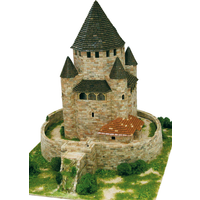Aedes Ars Caesar Tower Architectural Model Kit
Aedes Ars Caesar Tower Approximate number of pieces: 8,250 Difficulty degree: 8/10 Sizes: 400 x 500 x 415mm Scale: 1/170 These kits contain high quality ceramic pieces (which simulate the stones and the original materials), cardboard structure, glue, scenic material, and instructions. Aedes Ars produce a wide range of building sets which are used for the scale reproduction of some historical monuments such as castles, churches, bridges, and lighthouses, (some are recognised World Heritage Sites), as well as diverse miniature buildings of typical country constructions. The monument and its history The Tour Cesar (Caesar's Tower) is situated in Provins (Seine et Marne, France) at the top of the very hill over which the town is placed. It possesses some splendid views of the Brie Plateau. A legend dates the origins of Provins to the Roman era. Therefore, going by this legend, the large tower of Provins would have been built by Julius Caesar. In reality, the tower was built in the 12th century under the reign of Henry the Liberal (1152-1183). It can be confirmed that Caesar's Tower existed from 1137 because it is mentioned in a letter from Thibaud II where he designated the tower as the border for the markets of Champagne. It has had a great many uses: it has been a prison, shelter from possible attacks; its essential role has been military and has had several names such as “the King's Tower”, “the Grand Tower” and “the Prisoners' Tower”.Later, in the 15th century, the English tried, and succeeded, in taking control of the Tower of Provins and it was left in a bad state. It was the early 17th century when the mayor, François de Beaufort, decided to repair and put a new roof on it. The base of the building is surrounded by a heavy brickwork defensive wall, added by the English after 1432, known by the disdainful name of “Pâté aux Anglais”. It has a square ground plan at the base which becomes octagonal at half height (it is the only “donjon” with this characteristic), flanked by four turrets. Inside, below, a large vaulted hall was used as a deposit for military administration. On the upper floor, another hall of the same dimensions but higher, called the “guards' hall”, was the communication centre of the Tower. From here, the steps lead to the lower hall, the governor's room and the parapet walk. The dungeons where the prisoners were kept are reached by narrow corridors that are inside the walls. Even today one can still see perfectly the “Pâté aux Anglais” as well as the guards' hall, the governor's room and the other sections. The tower was roofed in 1554, and the installation of the bells, which came from the bell tower of the church of Saint-Quiriace, was undertaken in 1689.It all makes Provins one of the most beautiful medieval complexes in the environs of Paris. The city included as a UNESCO World Heritage Site is also the exceptional setting for many period shows.





